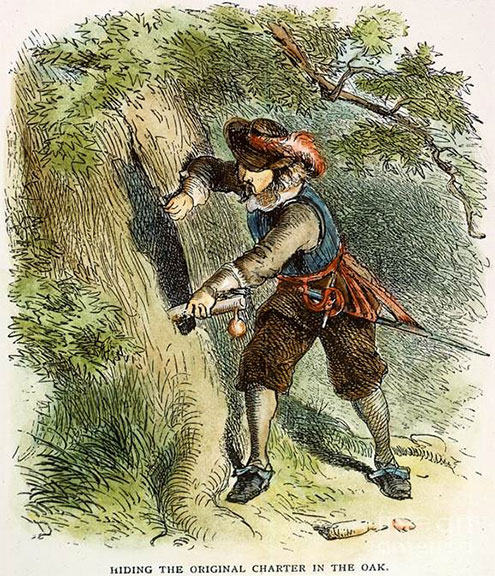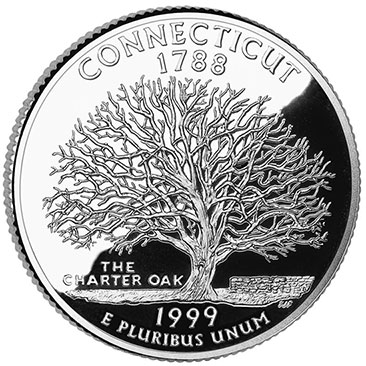Tapping the Scales of Justice - A Dose of Connecticut Legal History
A Symbol of Connecticut's Independence
The Royal Charter of 1662, granted by King Charles II, is one of the
earliest and most significant legal documents in Connecticut history. The
Charter, preceded only by the Fundamental Orders, is the source of the legend of the Charter Oak. While the Fundamental Orders, prepared by Roger
Ludlow and other leaders of the Colony in 1639, were considered the first constitution; the Charter was signed by the English King Charles II, and it
allowed the colony of Connecticut to make some of its own rules and elect certain officials. The Charter was important because it granted Connecticut
rights to govern itself.
The
Charter, preceded only by the Fundamental Orders, is the source of the legend of the Charter Oak. While the Fundamental Orders, prepared by Roger
Ludlow and other leaders of the Colony in 1639, were considered the first constitution; the Charter was signed by the English King Charles II, and it
allowed the colony of Connecticut to make some of its own rules and elect certain officials. The Charter was important because it granted Connecticut
rights to govern itself.
In 1687, King James II became intent upon gaining control of all the colonies and revoked the Royal Charters. He sent
his Agent with an armed troop to seize the document. Here the story takes a dramatic twist. In the candle lit meeting room, leaders of the Connecticut
colony met with Sir Edmond Andros, the King's Royal Governor of the Dominion. They gathered to debate the surrender of the Charter for several
hours. Suddenly the room went dark. When the confusion cleared and the candles were lit again, it was discovered that the Charter was gone from the
table. It was hidden in the trunk of a nearby large white oak tree.
The legend has endured to this day, its significance emphasized by the selection of the Charter Oak for the
 Connecticut State quarter design in 1999.
Connecticut was designated the Constitution State by the Connecticut General Assembly in 1959 (see the
Connecticut
Register and Manual
and the Secretary of State's
Documents of Connecticut Government: The Connecticut Constitution and its
Antecedents
).
Connecticut State quarter design in 1999.
Connecticut was designated the Constitution State by the Connecticut General Assembly in 1959 (see the
Connecticut
Register and Manual
and the Secretary of State's
Documents of Connecticut Government: The Connecticut Constitution and its
Antecedents
).
The Royal Charter can be viewed at the Museum of Connecticut History in the Connecticut State Library and Connecticut Supreme
Court complex. The frame is made of wood from the Charter Oak Tree.
On August 21, 1856, a violent storm felled the Charter Oak Tree which was estimated to be nearly 1,000 years old. A monument was erected in 1905 at
the location of the fallen tree. It stands at the corner of Charter Oak Avenue and Charter Oak Place in downtown Hartford. The monument is
inscribed, "Near this spot stood the Charter Oak, memorable in the history of the colony of Connecticut as the hiding place of the charter October 31, 1687. The tree fell August 21, 1856."
More information on the Charter Oak can be found on ConnecticutHistory.org at
Connecticut's "The Legend of the Charter Oak" and
The Charter Oak Fell - Today in History: August 21
Doses of Connecticut Legal History